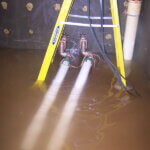Tips for Maintaining A Sump Pump
A sump pump is a valuable tool to keep your basement from flooding after a snowy winter or rainy spring in Chicago. When moving into a home with a sump pump, it’s helpful to know more about this appliance so you can keep it working properly. If you’ve never had one before, review this one-stop guide for some helpful tips for living with a sump pump.
What Does a Sump Pump Do?

As its name suggests, a sump pump removes water from the lowest area of a home, such as a basement, and pumps it to another area. Most sump pumps are located underneath the basement floor, though some sit above the floor. It works by using a sensor to identify when the water in the sump basin has exceeded a specific height. When the water reaches that height, the pump activates to remove the water through a pipe, draining it so it doesn’t damage your home’s foundation.
Not every home needs to have a sump pump. Usually, they’re installed in homes located in areas with frequent rain, snow, or flooding. In Chicago, a city that can experience heavy rains quickly, sump pumps are essential in many homes to keep them dry.
Benefits of Having a Sump Pump
If you’ve never lived in a home with a sump pump, you may be wondering whether it’s actually a useful tool to have. There are many benefits of having a sump pump in your home. It can help you:
- Protect your home: A sump pump can help you protect your home from flooding and water damage, particularly to the foundation.
- Save money on repairs: If water damage does occur, the repairs can be costly. Installing a sump pump is a proactive way to save hundreds or thousands of dollars.
- Avoid mold: When moisture collects in your basement, it becomes a breeding ground for mold. A sump pump keeps your basement dry to help you avoid mold.
- Keep your stuff dry: If your store items in your basement, such as holiday decorations or tools, a sump pump can help keep your stuff dry after heavy rains.
- Get reduced insurance rates: Some insurance companies may offer lower rates on home insurance if you have a sump pump, especially if you live in an area prone to flooding.
Tips for Living With a Sump Pump
If you’re buying your first home with a sump pump (or your first home, period), knowing a few tips to keep your sump pump working correctly is helpful. These tips can help you avoid the costly cleanup and repairs that come with a flooded basement. Here are four tips for living with a sump pump:
Test the Sump Pump
The last thing you want is a non-functioning sump pump when a Chicago thunderstorm arrives. Be proactive by testing the sump pump periodically to make sure it’s working properly. Pour a 5-gallon bucket of water into the sump pump slowly. Watch to make sure the sump pump turns on and drains the water. If it doesn’t drain the water, shut off the sump pump and consider having a plumber take a look at it.
How often you test your sump pump may depend on how frequently it runs. If you live in an area with poor drainage, you may not need to test the sump pump often because it’s already running regularly. Test your sump pump more frequently, at least a few times a year, if it usually only runs during periods of heavy rainfall. If your sump pump rarely operates, test it at least once a year to make sure it’s still functioning correctly.
Listen to It Running
After you’ve lived with a sump pump for a while, you’ll become aware of the noises it makes when it runs, including the sound of the motor and moving water. Listen to it running to ensure it sounds normal when it kicks on. If you notice changes to the noise it makes, there could be a problem. Test the sump pump and contact a plumber if there’s an issue. Often, catching problems quickly can help you save money on costly repairs in the future.
Have a Battery Backup
It’s common for the power to go out during an intense storm in Chicago. Since your sump pump runs on electricity, it must have a battery backup to continue working during a power outage. The battery backup will keep the sump pump running until the power’s restored. Keep the battery dry so it won’t become damaged by water.
Maintain the Sump Pump
Like other areas of your home, the sump pump requires regular maintenance to keep it working its best. Perform this maintenance in early spring and late fall, so you’re prepared for periods of heavier precipitation. Here are some steps you can take to keep your sump pump running properly:
- Inspect the outlet and cord for possible damages, and unplug the sump pump before cleaning.
- Clean up any loose debris near the sump pump and around the pipes.
- Remove the pump and clean it thoroughly.
- Check the discharge pipe to make sure it’s unclogged.
- Look for signs of worn or damaged parts so you can replace them if needed.
- Test the sump pump to make sure it’s working.
Replace Your Sump Pump in Chicago
With spring quickly approaching, it’s the perfect time to evaluate your sump pump to ensure it works correctly. If it’s time for a replacement, we can help. At Allied Plumbing & Heating Supply Co., we offer a quality selection of name-brand sump pumps to meet the needs of homeowners in Chicago. Stop by our showroom and let our team of experts help you find the right sump pump to keep your basement dry. As a family-owned and operated business, we’re committed to providing exceptional service to help you update and maintain your home. Contact us today for more information.
Photo Credit: Sump pump by State Farm is licensed with CC BY 2.0



